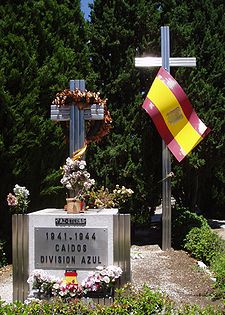- Miguel Ezquerra
-
Miguel Ezquerra Sanchez (1903? - 1984) was a Spanish Falangist, soldier and volunteer member of the Waffen-SS. He fought in the Spanish Civil War and in the Second World War, in a battalion of the Blue Division or 250. Infanterie-Division as it was known in the German Army.
Ezquerra was a Falangist and enthusiastically signed up for military service on the Nationalist side after the military coup of 18th July 1936. He fought on the fronts of Aragón, Madrid, Extremadura and Teruel, in the 7th "Bandera de Falange". After the end of the war he was demobilised, and worked as a teacher.
On hearing the news of the outbreak of the Second World War, he immediately visited the German embassy in Madrid, offering to enlist on the German side. His enthusiastic offer was noted, but tactfully declined. Later when Spain decided to send volunteers to assist German efforts on the Eastern front, he enrolled in the Blue Division. The Blue Division was ordered to the siege of Leningrad where it would eventually participate in the Battle of Krasny Bor.[1]
Later, after the Blue Division had been repatriated to Spain on April 2, 1944, he was determined to continue to fight. He secretly crossed the French border in April 1944 to enlist in the Wehrmacht, and he was eventually transferred into the Waffen-SS.
As part of the 11th SS Panzergrenadier Division "Nordland", and with the rank of Hauptsturmführer, Miguel Ezquerra helped defend Berlin against Soviet troops, commanding a unit formed by Spanish Fascists, who were among the last defenders of the bunker of Adolf Hitler.
Miguel Ezquerra was author of the book "Berlin, a vida o muerte" ("Berlin, to life or death"). Little is known about his later life. It is generally agreed that he was one of the most notable Spanish combatants in the Second World War. He received several decorations and awards, including the Knight's Cross of the Iron Cross and had German nationality granted to him personally by Hitler. (Cfr. Interview Review N. 339, Madrid, November 1982). [2] [3]
Some historians, such as Kenneth W. Estes, question the assertions made by Ezquerra himself, as no evidence has ever been found to corroborate his claims about the role he played. While no one denies he was present in Germany, his real rank and participation in some events can be questioned.
Ezquerra, for example, claims to have been promoted from Lieutenant to Lieutenant-Colonel, orally, between his 1944 arrival in Stablack and final combat in Berlin. During this time, he allegedly served in the Army's special operations unit, the "Brandenburgers," first fighting Maquis in and out of Paris, and then with his Spanish commando unit, fighting behind the American (!) lines in the Battle of the Bulge. He claimed to have had personal contact with Hitler, who orally (of course) awarded him the Knight's Cross; Himmler, Goebbels, and Berger; and to have seen Martin Bormann and Axmann. In the last days of the war, his "Ezquerra Unit" — now absorbed into the Waffen-SS, (although all his oral promotions had come from Army officers) consisted of three companies of Spaniards, some "Doriot Milice" [sic] and more Spaniards from the Walloon Division[4].
Since 1995, the remains of Ezquerra have rested next to those of his comrades in the Vault of the Blue Division, in cemetery of the Almudena (3rd Plateau, area A ) at Madrid.
Sources (in English)
Sources (in Spanish)
- Ezquerra, Miguel, Berlín, a vida o muerte. Ed. García Hipan. Granada, 1999.
- Nart, Javier, El jefe español de las SS en Interviu Review, 10-16 de Noviembre de 1982.
- Recio Cardona, Ricardo, Españoles en la Segunda Guerra Mundial (El frente del este). Ed. Vandalia. Madrid, 1999.
References
Categories:- 1900s births
- 1984 deaths
- People from Huesca
- Spanish people of the Spanish Civil War
- Spanish people of World War II
Wikimedia Foundation. 2010.

